
Introduction
Drafted
Operation Torch
Conversation Part 1
Sicily
Conversation Part 2
Anzio
Breakout
France
Germany
Austria
![]()

Anzio: January — May 1945
3rd Signal Co. Photographers
It doesn't sound like a story that came out of WWII but it was born at Anzio.
Fuzzy Fezell was an officer in the 3rd Signal Co. who didn't show up at the company very often, but when he did, things happened. I don't remember his rank but it was better than my corporal, probably a captain. He was known by his officer friends as "Fuzzy" because he didn't have any hair on top, just fuzz on the sides.
Photographic equipment and a method to produce a photo within the division were almost non-existing. When photos were needed, the division had to rely on photographic signal units at the corps level to take them. My outfit, the HQ Company of the Tenth Engineers, had a 4x5 Speed Graflex that was part of their equipment, but to develop and print a photo they had to rely on someone else because darkrooms were lacking.
The need for photos was great. Photos taken from L-5 Cub airplanes gave the infantry a photo of the ground they had to take. The division needed these and a fast way to produce photos for its history and many other needs. A photo tells a thousand words — aerial photography especially.
The 3rd Signal Co. was blessed with a fine carpenter, Sgt. Edward F. Kazewicz, who could create wheeled-trailers that housed communications facilities better than tents and shelters could. And they were mobile. Kazewicz's trailers were made from battlefield junk, both German and American. Eventually the company had more trailers than trucks. Kazewicz built a darkroom trailer under trying conditions at Anzio and it was christened "Fuzzy's Folly".
Now it was necessary to find a crew to take pictures, develop film and make prints.
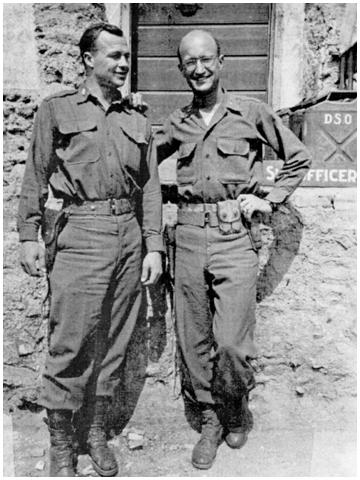
First Lt. George A. Fezell (right)
The first to be called upon was Sgt. Jack Cole who did the picture taking at the Tenth Engineer's HQ including, when called upon, to take photos from the L-5 Cub planes flown by the Artillery Observation Group. Jack was an amateur photographer and he was great in P.R.
Jack then called upon me, T/5 Howard Nickelson. Jack and I were fast friends. I had attended the Montana School of Mines for three years. I was never asked, but I was told, "You are going to the 3rd Signal Co. as a photographer." It sure beat making mine signs for posting in the Anzio mine fields. Later, a Tenth Engineer Battalion commander told me, "The 3rd Signal Co. shanghaied you and Jack."
Later Pvt. William Heller was transferred off a line company of the 15th Regiment. Bill was 35 or 36 years old and spent years as a professional photographer and had his own studio in Chicago. He was known as "Pop" Heller.
Pvt. Bill Toomey came from the Third Reconnaissance Company Battle Patrol. He had been a photographer with a newspaper near Boston. Bill was a small man and I don't know how he survived the rigors of the battle patrol. He had very small hands.
The last to come was Pvt. Robert Seesock. I believe he was a recruit off the boat and an amateur photographer. He looked and acted like the all-American boy.
The photo lab was well-equipped. It had an 8x10 contact printer that saw the bulk of the printmaking and the necessary large developing pans that fit by the printer that was built into the cupboard. An enlarger capable of handling 4x5 negatives along with the necessary lights and tools were part of the equipment.
One of the most important items was a Kodak manual that gave us all the information regarding development times et al. It was a bible for us. We had one 4x5 Speed Graflex camera and later obtained an L-5 aerial camera which was hand-operated with roll film and took 4x5 negatives. The L-5 had a fixed focus at 30 feet and beyond. It was a great camera for aerial pictures because it was fast to operate with its hand lever. We also had a decent G.E. light meter. Our own private cameras were used at times when the occasion arose.
The photo section pulled no guard duty or K.P., and we were always "Fezell's fair-haired boys". We would always bivouac with the 3rd Signal Co..
Most of my time was spent developing film, making prints and captioning prints and negatives. We made five prints for distribution. The developing and printing were under field conditions and temperature played an important role especially when it was hot. When it was below freezing the operation practically stopped as the developing solutions froze. Developer chemistry needed to be five degrees plus or minus of 70 degrees to be effective. Finding and keeping water to wash the film and prints was a problem. Unwashed prints turn yellow.
Jack Cole got the orders and assigned the crew or did it himself. He took a lot of the aerial photography and helped distribute the prints to whoever needed them. Jack rode a motorcycle and we had a jeep. Jack had a gift of gab and women loved him and vice versa.
Bill Heller, I never knew as well but he was a good photographer, married, Jewish and he played some baseball. We corresponded after the war, he had a couple of sons whose pictures were on his Christmas cards. After the war he continued operating his photo store in Chicago.
I did not hear from Bill Toomey or Bobby Seesock after the war.
I don't know what happened to "Fuzzy's Folly", but all the negatives, some 1,300 plus were burned. Sob! Sob! All that great work and history up in flames.
I can now tell stories of my experience with the Fuzzy's Folly group.
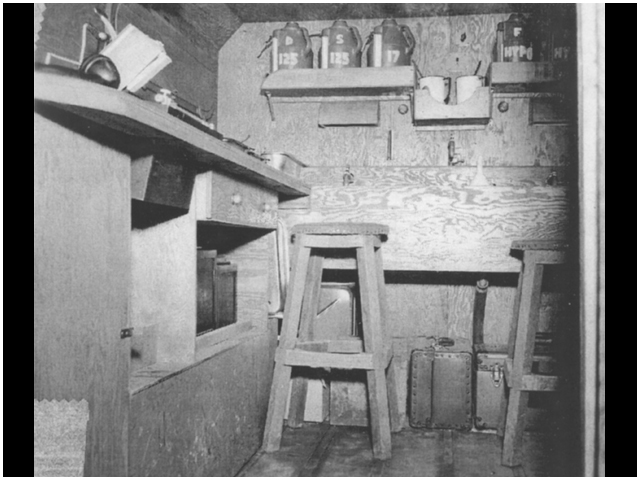
Inside Fuzzy's Folly on Anzio: Compact and efficient.
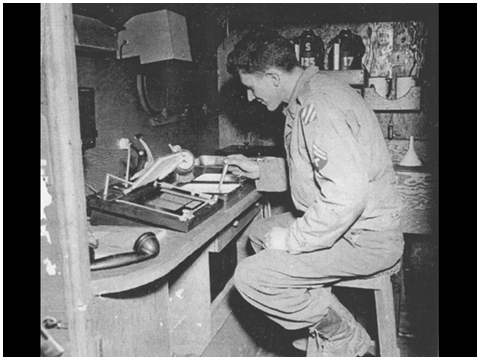
Howard Nickelson inside Fuzzy's Folly at Anzio
Jack Cole took numerous aerial photos of the hospital area. These units were field and evacuation units that grew to handle the great number of casualties that occurred from the bitter battles. When the wounded and sick patients were ready to be moved they were put on hospital ships and sent to the general hospital in Naples. There was an airstrip capable of handling large planes that could move patients off the beach. This airstrip was always under German artillery fire when it could be observed but the chemical company. did a good job of putting smoke over the beach when the conditions were right. The records from The 3rd Division history by Lt. Taggert show 6,295 battle casualties and 6,455 non-battle casualties from the 3rd Division alone. Thus the very large hospital area was needed when all of the other troops were considered. They were under the eyes of the Germans and maybe for nothing else to do the Germans fired shells into the area, missed directed rounds, and spent rounds from aerial attacks landed in the hospital area. All the personnel had foxholes and many of the tents were over holes but they and the sick and wounded became casualties. A hospital ship was sunk in the bay.
On February 7, 1944 a German pilot attempting to gain altitude dropped his bombs on the 95th Evac Hospital and killed 28 medical people, wounded 64 and damaged needed equipment.
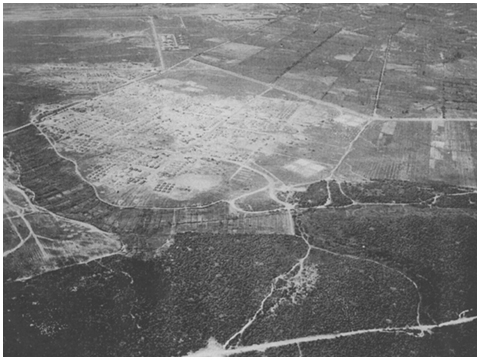
The hospital area at Anzio. At the top of the photo is the sea and at the bottom is unreclaimed land, groves of trees known as the Padiglione woods.
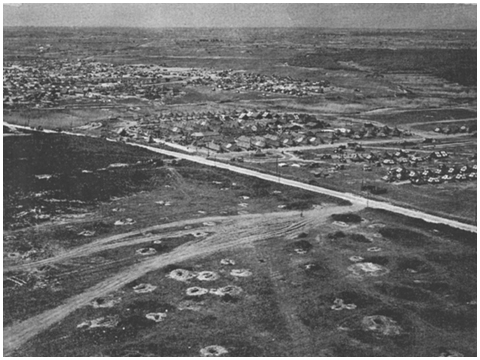
Part of the hospital area at Anzio. The holes in the foreground look like bomb craters. They are now used to store and protect whatever. (Jack Cole 1944)
Another trick the defenders of the beach pulled was to set up powerful searchlights near the front to see what the Germans were up to. How would you like to be with a German patrol in the American lines at night and have the lights go on? Ahh! Allus Kaput.
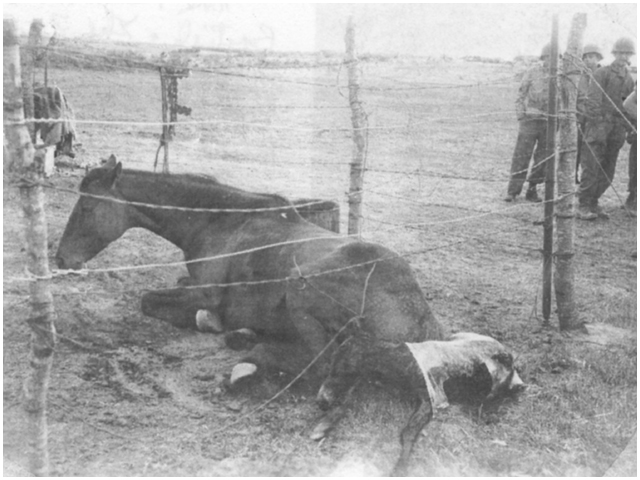
You would think such could not happen at Anzio. This mare was 1st Sgt Chatnnet's great love. He would see that she had something to eat and he would put her in a horse fox hole every evening. The day we moved out of Anzio on the way to Rome she had a colt. Upon close examination the colt was a mule colt. The good Sgt took one look and walked off in disgust. My great love, she had been cavorting with a jackass.
Aprilia: The Factory — The Pickle Factory
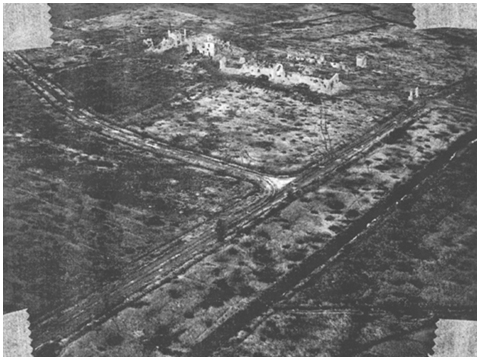
The Factory was a model farm community that was built in 1936 as a part of Mussolini's reclamation of the Pontine marshes. The Factory is on the Alban road, a main hard surface road that goes from Anzio eventually to Rome. The Factory's outer walls were built of red brick; the village was of masonry structure and some buildings were three or four stories high and when demolished by artillery the lower floors made a fortress. The main Alban highway and the numerous roads formed a hub at the Factory, a military objective. This area was the British battleground.
I have found two paperback books that describe the terrible battles that took place, centered around this Factory area. Anzio, the Gamble that Failed by Martin Blumenson 1963; I believe he was an American. And Anzio by Winford Vaughn-Thomas, a British war correspondent who was on the beach all during the campaign. Good.
On January 22, 1944, two reinforced Division landed at Anzio, one British one and one American, without noted opposition. The British Guards of the 1st Division on January 25, 1944 attacked, and by January 27 the Factory was in their hands. General Penney's 1st Division attacked on January 29 and 30 and drove for Campleone but was stopped short of his objective by overwhelming German forces. Strong pressure from the Germans to February 3 changed the American and British forces from attack to defense, and our forces hunkered down to stop the Germans from driving us off the beach.
On February 3, 1944 at 11 PM on a cold cloudy night the Germans drove into the British positions along the Alban highway beyond the Factory. By the evening of February 9, the Germans held the Factory. The British 1st Division was badly beaten and was being replaced piecemeal by the American 45th Divison and the 179th 1st Bn. and two companies of the 191st Tank Bn. on the 11th of February at 6:30am attacked to retake the Factory by dawn on the 12tu they were back from where they started.
By February 18th the front was back to the Flyover. On February the 19th the Germans made their last attempt to break our lines but they held in a blinding rainstorm. On March 2nd the skies cleared and 241 Liberators, 100 Forseares, 113 Lightnings, and 63 Thunderbolts unloaded their bombs over the Germans' forward and back positions. I saw some of those bombing runs and thought those poor bastards and I saw some of those planes get hit by shells from those dual 88s. The Germans offered a threat again. The fronts became relatively static, we held what we had. We never controlled the Factory again until the Germans were driven from the beach. It was not necessary, on May 26, 1944 the beachhead officially ceased to exist and by June 4th we were in Rome.
The Ranger
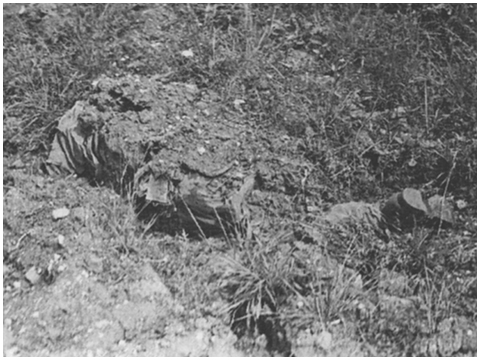
The US Ranger Force of these Battalions under Colonel Darby took the port of Anzio on D-day. The Rangers were specially trained troops, all volunteers, and they had combat experience in Sicily and Italy. The 1st and 3rd Battalions were chose to infiltrate deep into the German lines and into the town of Cisterna. On January 30th, 1944, they attempted to reach their objective. The Germans let them penetrate their lines and then surrounded them with tanks and SP guns. The result was of 767 men committed only six returned. The rest were either killed or captured. The battle for Cisterna was repulsed. In addition to losing two Battalions of Rangers, the 4th Battalion and several 3rd Infantry Division Battallion were badly mauled.
It was time to pull back, hunker down, and look to the sky, and say "Pass the Ammunition and praise the gods and guys who make the stuff and keep it coming."
The reason for the Ranger story is to introduce you to my story.
I was asked to join the 3rd Recon patrol to take photos, but it ended up that they captured a group of Germans. With a PRO guy I had to take the prisoners back to the PW cage at Cori. After awhile of roaming around alone trying to find a ride to the 3rd Signal Co. I came upon a group of infantry guys sitting along the banks of a sunken road. I was packing that old Speed Graphic and they said, "If you want to take some pictures and let the world know about it, go over in this direction 100 yards or so and you will be rewarded."
I saw a light machine gun with a couple dead near it. The dead soldier shown in the photo above was a short distance away. I had a strange feeling that I had intruded upon their hallowed ground. No Mans Land where they had lain for four months.
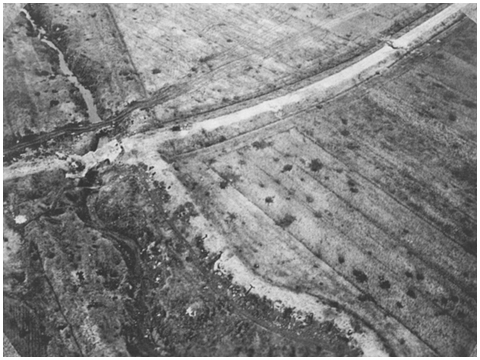
The Italians called streams that crisscrossed the beachhead Fosso-foso-fossi. The British called them wadi, and the Americans called them creeks and other things. Note the slit trenches and fox holes dug into the upper bank of the creek. The blown bridge was bypassed by a temporary bridge and dozer cuts across the banks. It can also be noted the road at the upper right had been blown. (Anzio 1944, photo by Jack Cole)
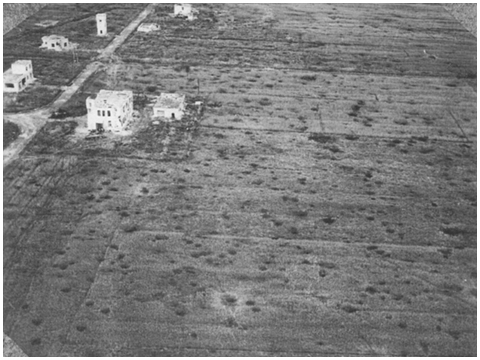
The sturdy farm homes were built for the farmers on the reclaimed lands on the plains east of Anzio. These houses were fought for as they proved to be a place of shelter and a fortress. Note the American tanks parked along the sheltered or friendly side of the two houses on the right side of the road. (Anzio 1944, photo by Jack Cole)
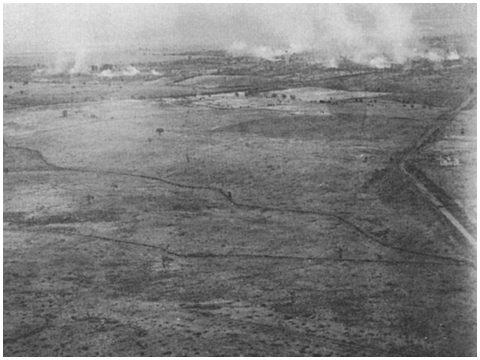
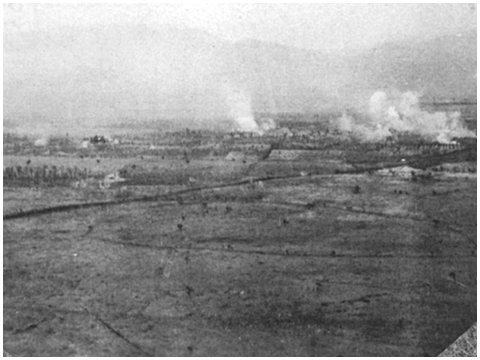
Two photos showing a 155 mm Artillery barrage into a German wooded area. The white plumes suggest the shells were the phosphorous variety, which causes nasty burns. These two photos were taken at almost the same time and place. Note the mountains in the background. Anzio 1944 photo by Jack Cole. I think Jack and his pilot were probably over or near the German held ground when he took that second picture. I don't think the Germans used phosphorous shells as they didn't have the phosphorous. We had mines in Idaho and Montana of this ore.
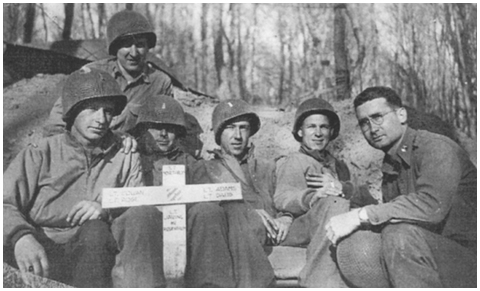
Officers of the 3rd Signal Co. Padigione woods, Anzio 1944. Jack Cole probably took this photo — he was making Brownie points.
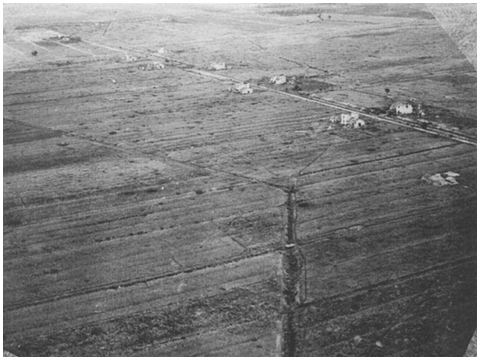
Another road lined with typical farm homes. These houses were designated by numbers to locate those occupied by our troops and those by the Germans. (Anzio 1944, photo by Jack Cole)
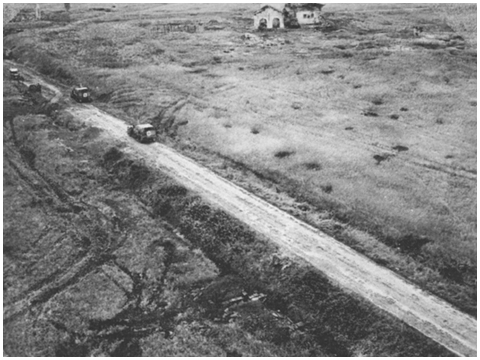
Two ambulance half trucks are making their way to the rear on a hard surface road. These roads were raised to make them passable when rains saturated the land off the roads. The road bank in the foreground by the friendly side. Probably ammunition is stored where the bohas are piled. It is amazing that Jack found all this activity during the day, as the Germans generally shich vehicle movement especially the two jeeps and men at the top left of the photo. (Anzio 1944, photo by Jack Cole)
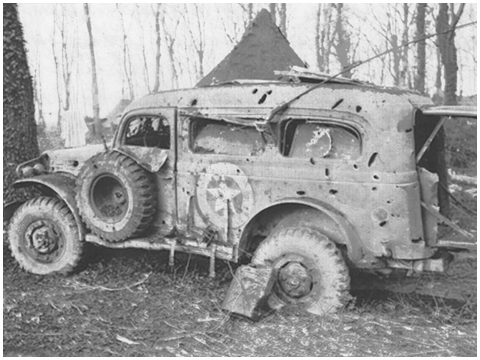
A 3rd Signal radio panel truck just got too close to Anne's business end. While was at the company area of the 3rd Signal Co. in Padiglione woods serveral shells from this gun landed in the company area. We had one man killed from shrapnel one day and I got up one morning to find large snarled pieces of shell fragments on the ground. It apparently burst in a tree. We here all hunkered down in covered foxholes. (Anzio 1944)
Conca: The Castle — 3rd Infantry Division Headquarters at Anzio
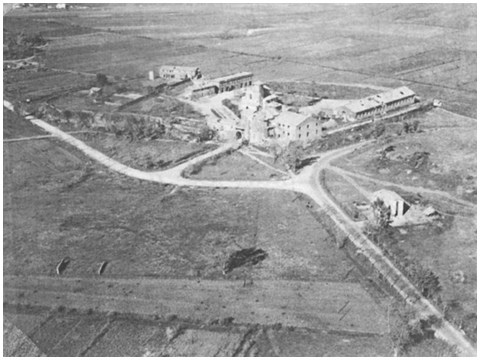
The 3rd Division chose this landmark for their division headquarters. The lower floors of these massive buildings offered protection from bombing and shellings. It was known that the Germans used the tower to zero their artillery, and this part of the complex got its share of the artillery shells.
One day while I was at Le Ferrier, General Clarke and his jeep came from the beach to visit the headquarters, which I would guess were only a mile or so on the road at the lower right. The Germans spotted the jeep in the bright day and proceeded to see if they could get a jeep. After the first round that missed the jeep driver would put the metal to the throttle until he thought the time interval was right for another round. He would then slow down, and the 88 round would explode ahead of him. This procedure went along for about three times with the same results. Then they hit the safety of the Castle. Anybody traveling the roads was fair game during the day when the Germans had you observed.
Le Ferriere - Home of Howard B. Nickelson
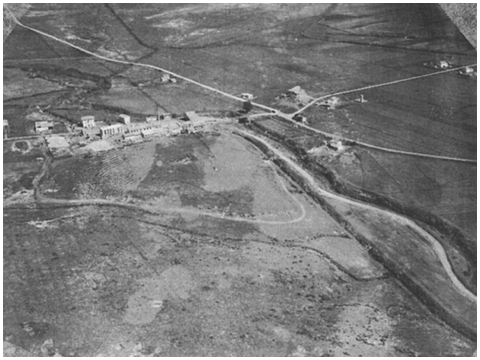
This small community was a factory town, an important hard road junction along a small river. It was also headquarters for the 10th Engineer Bn which was located in the farm house at the point formed by right hand projections of the number ones. The bridge across the small river had been blown, and it was replaced with a Bailey bridge. There was a considerable amount of water flowing in the stream. The 10th Engr. Bn used the farm house for their headquarters. It really was built of native stone with walls a couple feet thick. A foot bridge across the stream opposite these buildings had been built probably prior to the building of the Bailey bridge. There was also a canal, apparently dug to serve as a drain for the Factory and village; it flowed along side the stream.
Now my story. If you will project at right angles from the side of the photo at number two, you will notice a hole in the ground. When the days at Anzio were critical the 10th Engineers had a 2-ton truck with 700 anti-tank mines that were out of their boxes and the fuses were inserted and stacked loose in the truck. The truck was parked at the hole location and a camouflage net covered the truck. Each anti-tank mine was made up of six pounds of TNT.
I was with supply at that time and I left the SP and went to where the truck was parked one morning to see what had happened during the night. I was at the rear of the truck and I heard a pop like a pistol shot and I knew that an 88 round was coming close. I flopped down on the back of the canal and the round landed about three feet in front of me. I was sprayed with mud. Before that round landed it sounded as if somebody had poured water in hot grease. A few seconds later another pop and a ear shattering sizzle with shell landing in the canal about ten feet from me, then another pop and screaming sizzle and the third round landed in the far bank of the canal. No more pops and I decided it was time to get out of the canal with water and blackberry bushes up to my armpits. I went to the barn at the CP and was looking for some dry clothes when Jerry scored. Even in the barn I was knocked down and flung across the room. Panic in the CP but nobody was seriously hurt. From study of the windows at the factory it appears that they were blown out. The Germans thought that a tank was under that bump in the field and were using AP shells to try to destroy it. Count me blessings it was AP. I don't know who was responsible for putting a truck out in a field in plain sight.
Well that morning wasn't so dull but the afternoon was about par with the morning.
The Germans didn't like that Bailey bridge and they proceeded to try destroying it with artillery fire. The guys in the CP had dug fox holes in the bank of the stream nearest the CP. Anyway I was hunkered down in my fox hole which was about three feet deep. Well the Kraut artillery guns started to throw heavy stuff at the bridge and it was landing over my fox hole area. I don't know how long it went on but for quite some time - to long. Captain Carnell had started a hole about 10 feet from mine and all it needed now was some cleaning out. I don't believe they ever hit that bridge to damage it. The moral to this story - don't camp by a Bailey bridge.
I don't believe anyone has ever lived a complete life without the experience of lying in a fox hole under a German artillery barrage.
Anzio's Quartermaster Rodeo
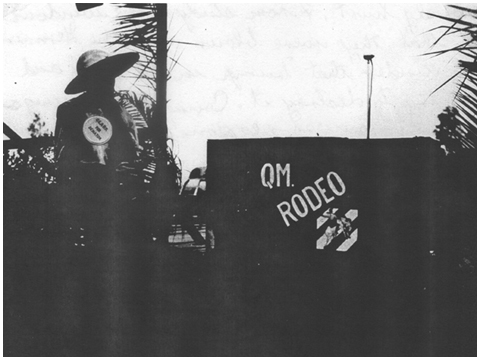
On May 7, 1944 at Anzio everything was under control, smoke obscured the area, the 3rd Division thought it was time to honor the brave and relax a bit. The QM put on a rodeo with bareback horseracing and other things that they thought would get by.
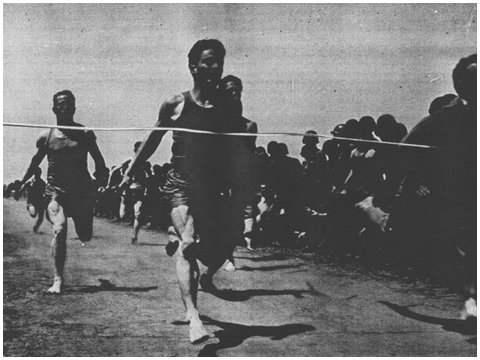
Those two guys in front excelled in the Truscott trot. Anzio Olympics shivvies and no shoes.
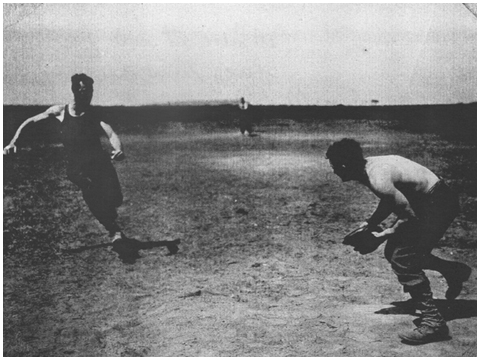
Where is that damned base?
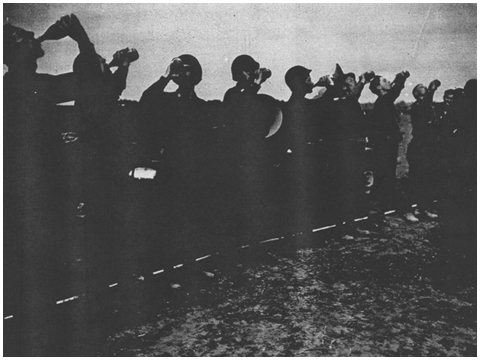
Where did they get the beer? I see any labels on the bottles. Wasn't brewed in Naples by the black market? Then minutes later: Where is the biffy?
Easter at Anzio
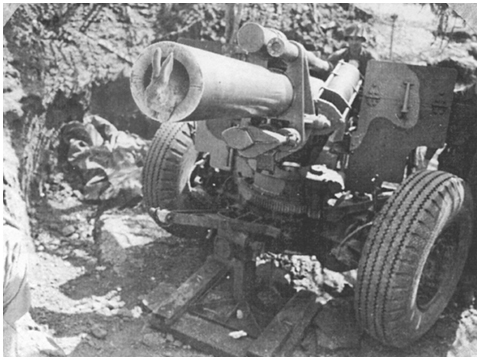
Thought we should send an Easter message to the Germans but on second thought it would be pretty hard on the rabbit. This was the work horse gun of the artillery, a 155 mm howitzer. It was dug in along side a road. No, I didn't eat the rabbit. (Photo by HB Nickelson, Anzio 1944)
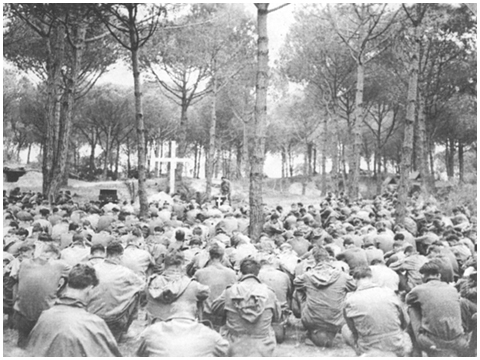
This Easter Service was held in the woods with protection of smoke. Church services were always hard to have as it was not wise to put many people together in a small area. The danger of shelling and strafing was always a serious threat but this Easter service brought a good gathering. (Anzio 1944)
Battle Sleds
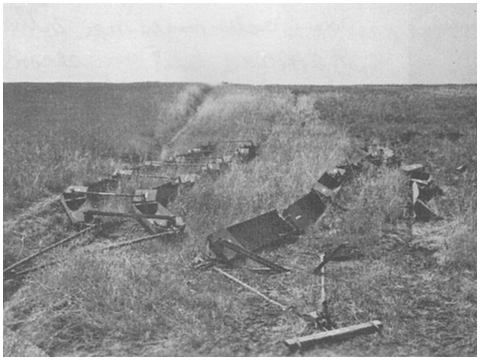
Sleds: Because the need to have infantry with the advancing tanks these metal sleds were made with hopes of solving this problem and giving soldiers a greater degree of protection. They were made at Anzio and extensively tested but they were found not to work. The photo shows them abandoned after the tests. (Anzio 1944)
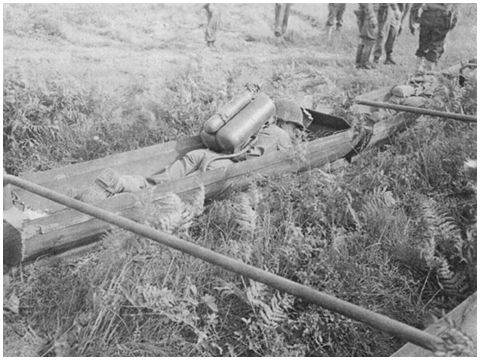
This was the way those battle sleds were supposed to work. That is a flame thrower on that soldiers back.
American Commanders
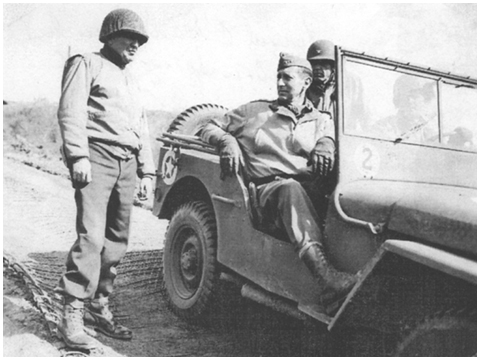
General Mark Clark and General John W. O'Daniel at Anzio or on the way to Rome. General Clark was 5th Army Commander and General O'Daniel was 3rd Division Commander. The third man is a colonel. General O'Daniel was well liked by our troops. (Spring of 1944)
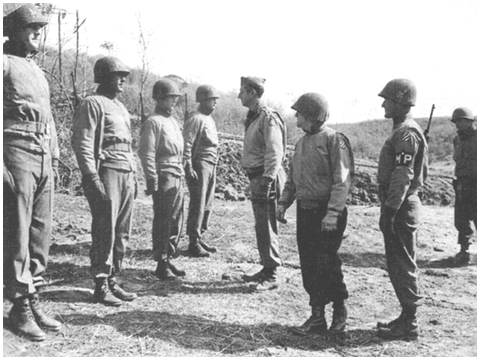
General Clark and General O'Daniel inspect the 3rd MP Honor Guard somewhere in Italy. (Spring of 1944)
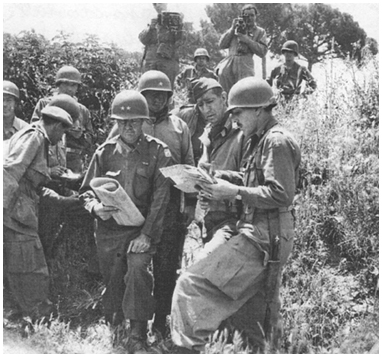
General Clark and General Fredrick confer on the way to Rome, May 1944. I have no idea who the rest of the group are. General Frederick is on the right.
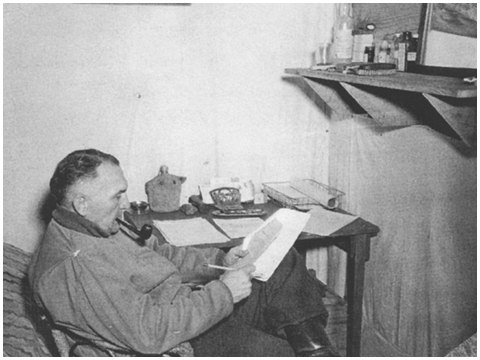
General O'Daniel in his quartersin the Spring of 1944. We were lucky the Division had good Generals and Regimental Commanders.
Howard B. Nickelson |
Introduction |
Drafted |
Operation Torch.
Conversation Part 1 |
Sicily |
Conversation Part 2 |
Anzio
Breakout |
France |
Germany |
Austria
Memoir appears by permission |